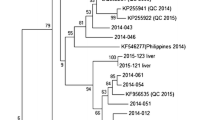Abstract
Hepatitis E virus (HEV) is an emerging causative agent of food and waterborne hepatitis in human beings. HEV circulates among human populations and swine herds, and may be found in water contaminated by swine feces, as well as in pork. In the present study, 68 sediment samples and 250 water samples collected from the Sinos River tributaries, as well as 50 samples of pork products (pâté and blood sausage) marketed in the Sinos River watershed region, Brazil, were tested for the presence of HEV genome. Reverse-transcriptase polymerase chain reaction followed by nucleotide sequencing was used for detection and characterization of HEV genomes. Overall, 36 % of food samples tested positive for HEV (genotype 3). No sediment or water samples were positive. These results suggest that contaminated pork products may be a source of HEV infection within this region and indicate a need for better monitoring of food safety and swine herds.

Similar content being viewed by others
References
Balayan, M. S., Andjaparidze, A. G., Savinskaya, S. S., Ketiladze, E. S., Braginsky, D. M., & Savion, A. P. (1983). Evidence for a virus in non-A, non-B hepatitis transmitted via the fecal-oral route. International Virology, 20, 23–31.
Barnaud, E., Rogee, S., Garry, P., Rose, N., & Pavio, N. (2012). Thermal inactivation of infectious hepatitis E virus in experimentally contaminated food. Applied and Environmental Microbiology, 78, 5153–5159.
Berto, A., Martelli, F., Grierson, S., & Banks, M. (2012). Hepatitis E virus in pork food chain, United Kingdom, 2009–2010. Emerging Infectious Diseases, 18, 1358–1360.
Clemente-Casares, P., Pina, S., Buti, M., Jardi, R., Martin, M., Bofill-Mas, S., & Girones, R. (2003). Hepatitis E virus epidemiology in industrialized countries. Emerging Infectious Diseases, 9(4), 448–454.
Da Costa Lana, M. V., Gardinali, N. R., da Cruz, R. A., Lopes, L. L., Silva, G. S., Caramori Júnior, J. G., et al. (2014). Evaluation of hepatitis E virus infection between different production systems of pigs in Brazil. Tropical Animal Health and Production, 46, 399–404.
dos Santos, D. R., Vitral, C. L., de Paula, V. S., Marchevsky, R. S., Lopes, J. F., Gaspar, A. M., et al. (2009). Serological and molecular evidence of hepatitis E virus in swine in Brazil. The Veterinary Journal, 182, 474–480.
Egloff, M. P., Malet, H., Putics, A., Heinonen, M., Dutartre, H., Frangeul, A., et al. (2006). Spontaneous emotion regulation during evaluated speaking tasks: associations with negative affect, anxiety expression, memory and physiological responding. Journal of Virology, 80(17), 8493–8502.
Emerson, S. U., Arankalle, V. A., & Purcell, R. H. (2005). Thermal stability of hepatitis E virus. Journal of Infectious Diseases, 192(5), 930–933.
Erker, J. C., Desai, S. M., & Mushahwar, I. K. (1999). Rapid detection of Hepatitis E virus RNA by reverse transcription-polymerase chain reaction using universal oligonucleotide primers. Journal of Virology Methods, 81, 109–113.
Feagins, A. R., Opriessnig, T., Guenette, D. K., Halbur, P. G., & Meng, X. J. (2007). Detection and characterization of infectious Hepatitis E virus from commercial pig livers sold in local grocery stores in the USA. Journal of Genetics Virology, 88, 912–917.
Feagins, A. R., Opriessnig, T., Guenette, D. K., Halbur, P. G., & Meng, X. J. (2008). Inactivation of infectious hepatitis E virus present in commercial pig livers sold in local grocery stores in the United States. Journal of Food Microbiology, 123, 32–37.
Figueiredo, J. A. S., Drumm, E., Rodrigues, M. A. S., & Spilki, F. R. (2010). The Rio dos Sinos watershed: An economic and social space and its interface with environmental status. Brazilian Journal of Biology, 70, 1131–1136.
Gardinali, N. R., Barry, A. F., Otonel, R. A., Alfieri, A. F., & Alfieri, A. A. (2012). Hepatitis E virus in liver and bile samples from slaughtered pigs of Brazil. Memorias do Instituto Oswaldo Cruz, 107, 935–939.
Hall, T. A. (1999). BioEdit: A user-friendly biological sequence alignment editor and analysis program for Windows 95/98/NT. Nucleic Acids Symposium Series, 41, 95–98.
Hoofnagle, J. H., Nelson, K. E., & Purcell, R. H. (2012). Hepatitis E. New England Journal of Medicine, 367(13), 1237–1244.
Katayama, H., Shimasaki, A., & Ohgaki, S. (2002). Development of a virus concentration method and its application to detection of Enterovirus and Norwalk Virus from coastal seawater. Applied and Environmental Microbiology, 68, 1033–1039.
Kuniholm, M. H., Purcell, R. H., McQuillan, G. M., Engle, R. E., Wasley, A., & Nelson, K. E. (2009). Epidemiology of hepatitis E virus in the United States: Results from the Third National Health and Nutrition Examination Survey, 1988–1994. Journal of Infectious Diseases, 200(1), 48–56. doi:10.1086/599319.
Labrique, A. B., Zaman, K., Hossain, Z., Saha, P., Yunus, M., Hossain, A., Ticehurst, J. R., & Nelson, K. E. (2010). Epidemiology and risk factors of incident hepatitis E virus infections in rural Bangladesh. American Journal of Epidemiology, 172(8), 952–961. doi:10.1093/aje/kwq225.
Lee, G. H., Tan, B. H., Teo, E. C. Y., Lim, S. G., Dan, Y. Y., Wee, A., & Purdy, M. A. (2015). Chronic infection with camelid hepatitis E virus in a liver transplant recipient who regularly consumes camel meat and milk. Gastroenterology, 150, 355–357.
Lopes dos Santos, D. R., Lewis-Ximenez, L. L., da Silva, M. F., de Sousa, P. S., Gaspar, A. M., & Pinto, M. A. (2010). First report of a human autochthonous hepatitis E virus infection in Brazil. Journal of Clinical Virology, 47, 276–279.
McCreary, C., Martelli, F., Grierson, S., Ostanello, F., Nevel, A., & Banks, M. (2008). Excretion of hepatitis E virus by pigs of different ages and its presence in slurry stores in the United Kingdom. Veterinary Record, 163, 261–265.
Meng, X. J. (2010). Recent advances in hepatitis E virus. Journal of Viral Hepatitis, 17(3), 153–161.
Meng, X. J., Purcell, R., Halbur, P., Lehman, J., Webb, D., Tsareva, T., et al. (1997). A novel virus in swine is closely related to the human hepatitis E virus. Proceedings of the National Academy of Sciences USA, 94, 9860–9865.
Mirazo, S., Ramos, N., Russi, J. C., Gagliano, G., & Arbiza, J. (2011). Detection and molecular characterization of sporadic cases of acute human hepatitis E virus infection in Uruguay. Archives of Virology, 156(8), 1451–1454.
Mizuo, H., Yazaki, Y., Sugawara, K., Tsuda, F., Takahashi, M., & Nishizawa, T. (2005). Possible risk factors for the transmission of hepatitis E virus and for the severe form of hepatitis E acquired locally in Hokkaido, Japan. Journal of Medicine Virology, 76(3), 341–349.
Munne, M. S., Vladimirsky, S., Otegui, L., Castro, R., Brajterman, L., & Soto, S. (2006). Identification of the first strain of swine hepatitis E virus in South America and prevalence of anti-HEV antibodies in swine in Argentina. Journal of Medicine Virology, 78(12), 1579–1583.
Nakai, I., Kato, K., Miyazaki, A., Yoshii, M., Li, T. C., Takeda, N., et al. (2006). Different fecal shedding patterns of two common strains of hepatitis E virus at three Japanese swine farms. American Journal of Tropical Medicine Hygiene, 75, 1171–1177.
Pavio, N., Meng, X.-J., & Doceul, V. (2015). Zoonotic origin of hepatitis E. Current Opinion in Virology, 10, 31–41.
Pischke, S., Stiefel, P., & Franz, B. (2012). Chronic hepatitis E in heart transplant recipients. American Journal of Transplantation, 11, 3128–3133.
Purcell, R. H., & Emerson, S. U. (2008). Hepatitis E: An emerging awareness of an old disease. Journal of Hepatology, 48(3), 494–503.
Pérez-Gracia, M. T., Suay, B., & Mateos-Lindemann, M. L. (2014). Hepatitis E: An emerging disease. Infection, Genetics and Evolution, 22, 40–59.
Renou, C., Gobert, V., Locher, C., Moumen, A., Timbely, O., & Savary, J. (2014). Prospective study of hepatitis E virus infection among pregnant women in France. Virology Journal, 11, 68.
Smith, D. B., Simmonds, P., Jameel, S., Emerson, S. U., Harrison, T. J., Meng, X. J., & Purdy, M. A. (2014). Consensus proposals for classification of the family Hepeviridae. Journal of General Virology, 95(10), 2223–2232.
Song, Y. J., Park, W. J., Park, B. J., Lee, J. B., Park, S. Y., Song, C. S., & Choi, I. S. (2014). Hepatitis E virus infections in humans and animals. Clinical and Experimental Vaccine Research, 3(1), 29–36.
Tamura, K., Stecher, G., Peterson, D., Filipski, A., & Kumar, S. (2013). MEGA6: Molecular Evolutionary Genetics Analysis version 6.0. Molecular Biology and Evolution, 30(12), 2725–2729. doi:10.1093/molbev/mst197.
Tei, S., Kitajima, N., Takahashi, K., & Mishiro, S. (2003). Zoonotic transmission of hepatitis E virus from deer to human beings. Lancet, 362(9381), 371–373.
Thompson, J. D., Gibson, T. J., Plewniak, F., Jeanmougin, F., & Higgins, D. G. (1997). The CLUSTAL_X windows interface: Flexible strategies for multiple sequence alignment aided by quality analysis tools. Nucleic Acids Research, 25(24), 4876–4882.
Vasconcelos, J., Staggemeier, R., Soliman, M., Heinzelmann, L. S., Cimirro, R., Silva, A. D., et al. (2015). Molecular detection of hepatitis E virus in feces and slurry from swine farms, Rio Grande do Sul, southern Brazil. Arquivo Brasileiro de Medicina Veterinária e Zootecnia, 67, 777–782.
Vecchia, A. D., Fleck, J. D., Comerlato, J., Kluge, M., Bergamaschi, B., Da Silva, J. V. S., & Zanin, J. G. (2012). First description of Adenovirus, Enterovirus, Rotavirus and Torque teno virus in water samples collected from the Arroio Dilúvio, Porto Alegre, Brazil. Brazilian Journal of Biology, 72(2), 323–329.
Velazquez, O., Stetler, H. C., Avila, C., Ornelas, G., Alvarez, C., & Hadler, S. C. (1990). Epidemic transmission of enterically transmitted non-A, non-B hepatitis in Mexico, 1986–1987. Journal of American Medicine Association, 263(24), 3281–3285.
Wenzel, J. J., Preiss, J., Schemmerer, M., Huber, B., Plentz, A., & Jilg, W. (2011). Detection of hepatitis E virus (HEV) from porcine livers in southeastern Germany and high sequence homology to human HEV isolates. Journal of Clinical Virology, 52, 50–54.
World Health Organization (WHO). (2009). Viral Hepatitis. Report by the Secretariat. Sixty-second World Health Assembly, A66/22. Provisional agenda item 12.17. Geneva: WHO. http://apps.who.int/gb/ebwha/pdf_files/A62/A62_22-en.pdf. Accessed 04 Jan 2016.
World Health Organization (WHO). (2015). Global Health Observatory data repository. http://apps.who.int/gho/data/view.main.CODREG6AMRV?lang=en. Accessed 06 Dec 2015.
Yazaki, Y., Mizuo, H., Takahashi, M., Nishizawa, T., Sasaki, N., Gotanda, Y., & Okamoto, H. (2003). Sporadic acute or fulminant hepatitis E in Hokkaido, Japan, may be foodborne, as suggested by the presence of hepatitis E virus in pig liver as food. Journal of Genetics Virology, 84, 2351–2357.
Zhu, F. C., Zhang, J., Zhang, X. F., Zhou, C., Wang, Z. Z., & Huang, S. J. (2010). Efficacy and safety of a recombinant hepatitis E vaccine in healthy adults: A large-scale, randomised, double-blind placebo-controlled, phase 3 trial. Lancet, 376(9744), 895–902.
Acknowledgments
FHH is a Coordenação de Aperfeiçoamento de Pessoal de Nível Superior (CAPES) scholarship recipient and FRS is a National Research Council (CNPq) fellow. This work was financially supported by FINEP (MAIS-AGUA); CNPq and CAPES.
Author information
Authors and Affiliations
Corresponding author
Rights and permissions
About this article
Cite this article
Heldt, F.H., Staggmeier, R., Gularte, J.S. et al. Hepatitis E Virus in Surface Water, Sediments, and Pork Products Marketed in Southern Brazil. Food Environ Virol 8, 200–205 (2016). https://doi.org/10.1007/s12560-016-9243-7
Received:
Accepted:
Published:
Issue Date:
DOI: https://doi.org/10.1007/s12560-016-9243-7




